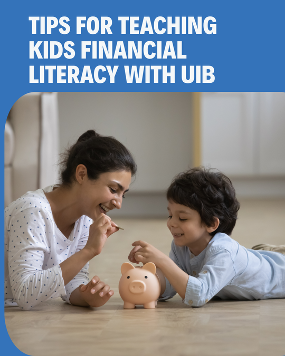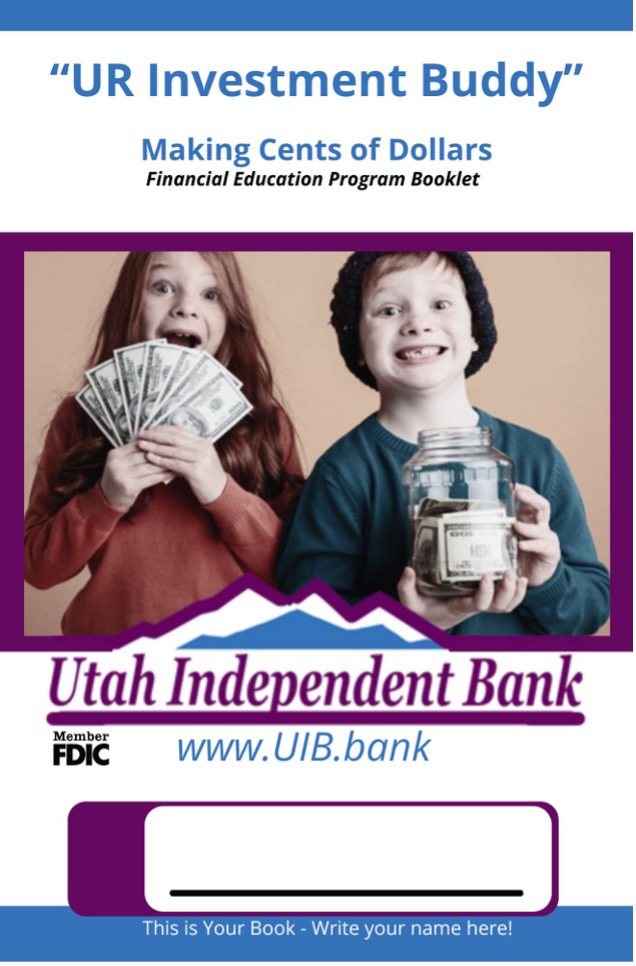
As parents, we teach our children how to read, ride bikes, and be kind—but what about money? Building strong financial habits early is one of the most important life lessons we can give. Fortunately, it’s never too soon (or too late) to begin teaching your child about how money works—and Utah Independent Bank (UIB) is here to support you every step of the way.
From opening a youth savings account to learning about budgeting and the power of compound interest, UIB offers tools, resources, and programs to help parents teach financial literacy in Utah in ways that are fun, practical, and lasting. When it comes to teaching kids about money, consistent exposure and meaningful conversations go a long way.
Why Teaching Kids About Money Matters
Studies show that children start forming money habits as early as age 7. If we wait until they are teens to introduce budgeting, saving, and spending, we may be playing catch-up. By teaching kids the value of money from a young age, we empower them to:
- Understand the difference between needs and wants
- Set and achieve savings goals
- Make informed decisions
- Avoid common debt traps later in life
- Build lifelong confidence in managing their finances
When kids learn to manage their money early, they are more likely to carry those habits into adulthood. These skills aren't just about managing an allowance—they're about preparing children for life. When you talk to your kids about saving, budgeting, and spending wisely, you're helping them build independence and confidence.
Financial literacy Utah initiatives, like those offered through UIB, provide the structure families need to make money conversations part of everyday life. Resources like workshops, hands-on materials, and accessible account options make it easier for parents to keep the learning going at every stage of growth.

1. Start Simple, Start Early
Young children learn best through simple, concrete examples. Here’s how you can introduce the basics:
- Use a clear jar or piggy bank: Let them see their money grow over time.
- Explain transactions at the store: “We’re paying $3 for this milk with money from our bank account.”
- Give small, age-appropriate allowances: Even $1–$5 a week helps reinforce the concepts of saving, spending, and giving.
- Play money games: Board games like Monopoly Junior or The Game of Life offer great lessons in a fun way.
The earlier you begin teaching kids about money, the more natural money conversations will feel. Encourage your child to make small choices with their money. Ask them questions like, “Would you rather spend your $2 on candy today, or save it to buy that toy next week?” These small decisions build decision-making power.
UIB Tip: Open a Youth Savings Account for your child as soon as they're ready. Watching their balance grow with real dollars reinforces saving habits more than any pretend money ever could. UIB savings accounts are designed with kids in mind and serve as a valuable tool for parents who want to promote financial literacy in Utah.

2. Use Real-World Learning Opportunities
Life offers countless teaching moments—make the most of them:
- At the ATM: Explain that it’s not “free money”—it’s coming from your account.
- At the grocery store: Let your child help compare prices or stick to a budget.
- When saving for something special: Help them create a plan. “You’ll need to save $2 a week for 6 weeks to buy that toy.”
Encourage your child to earn their own money through small jobs like dog walking, raking leaves, or lemonade stands. Then walk them through the steps of what to do with their earnings—save, spend, or share?
Real-world moments matter. Don’t be afraid to bring your child along to the bank, let them interact with tellers, or help them make a deposit. These actions make banking feel normal and empower children to view money as a tool they can control. At Utah Independent Bank, our friendly team is always happy to make young savers feel welcome.
By incorporating your child into regular financial activities, you're reinforcing essential skills. Whether you're depositing a paycheck, writing a grocery list, or reviewing bills, you're building a foundation for smart choices.

3. Use UIB’s “UR Investment Buddy” Making Cents of Dollars Program
UIB offers a unique educational program called “UR Investment Buddy” Making Cents of Dollars designed specifically for children ages 7–12. Here's how it works:
- Stop by any UIB branch to pick up the free UR Investment Buddy booklet
- Complete fun, age-appropriate activities that teach core financial concepts
- Once completed, your child earns $25 toward their UIB savings account
This program isn’t just a handout—it’s a conversation starter. Parents can work side-by-side with their kids through the activities and reflect on how money works in the real world. It's a fantastic bridge between play and responsibility.
Programs like this one are central to teaching kids about money. The activities are engaging and designed to promote discussion and practical understanding. Whether it’s learning about needs vs. wants or setting a short-term savings goal, each page builds skills.
Not only do children get excited about earning a reward, but parents also appreciate the support in beginning these critical conversations. Plus, the incentive of a deposit into their UIB savings accounts helps reinforce positive financial behavior. It’s another reason UIB continues to be a trusted resource for financial literacy that Utah families can rely on.

4. Help Older Kids Set Goals and Budgets
As your child matures, so should their financial understanding. For pre-teens and teens:
- Introduce budgeting apps or simple spreadsheets
- Help them create short- and long-term savings goals (e.g., a bike, college fund)
- Discuss checking accounts, debit cards, and how to avoid overdraft fees
- Talk openly about real-world expenses like rent, insurance, and student loans
Give teens the freedom to manage small expenses on their own—and let them learn from their mistakes. The earlier they develop money management skills, the more confident they’ll be in adulthood.
As your teen starts earning income through part-time work or gifts, consider setting up a system: 70% save, 20% spend, 10% give. This basic model introduces budgeting and aligns with core financial literacy Utah principles.
UIB offers teen-friendly account features and support through UIB savings accounts that grow with your child. Parents and teens alike can benefit from tools like automatic transfers, mobile banking, and balance alerts. These tools make teaching kids about money a practical, real-life experience that sticks.
5. Encourage Giving, Not Just Saving
Teaching generosity is just as important as teaching savings. Encourage your child to set aside part of their money for charitable giving or helping others.
- Let them choose a cause that matters to them (animals, environment, local shelters)
- Involve them in giving decisions—whether it’s donating money, time, or toys
- Celebrate the why behind giving: making a difference in someone else’s life
It’s essential for kids to understand that money is not just for personal gain. By introducing the concept of giving, you're helping your child become financially and socially responsible.
Use holidays, birthdays, or community drives as opportunities to discuss how your family supports others. Ask, “How would you like to help someone this year?” These conversations tie into the broader mission of financial literacy Utah programs, which aim to build thoughtful, future-minded citizens.
Giving can be as simple as donating to a school fundraiser or buying a toy for a child in need. It creates a full-circle understanding of money management and complements everything else you're doing in teaching kids about money.
Programs like “UR Investment Buddy” Making Cents of Dollars and tools like UIB savings accounts make it easy to fold giving into the conversation without overwhelming your child. It becomes just another part of being a smart, compassionate saver.
Final Thoughts
Financial literacy isn’t a single conversation—it’s a lifelong skill set. But when you start early, keep it simple, and reinforce your child’s progress, they’ll grow up feeling confident, capable, and in control of their money.
Let UIB be your partner in raising smart savers and future financial leaders. Stop by any of our branches today to get started with a savings account, pick up your “UR Investment Buddy” Making Cents of Dollars booklet, or chat with a team member about your family’s goals.
Together, we can build stronger futures—one habit, one dollar, one lesson at a time.
Disclaimer: The views and opinions expressed in this post do not necessarily reflect the official policy or position of Utah Independent Bank. This post is intended for entertainment and/or informational purposes only and should not be construed as financial advice or an endorsement of any product or service.


